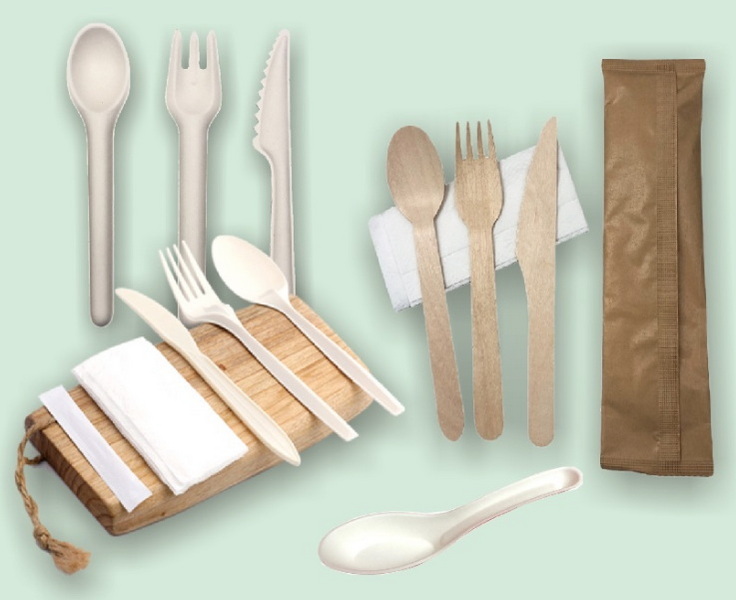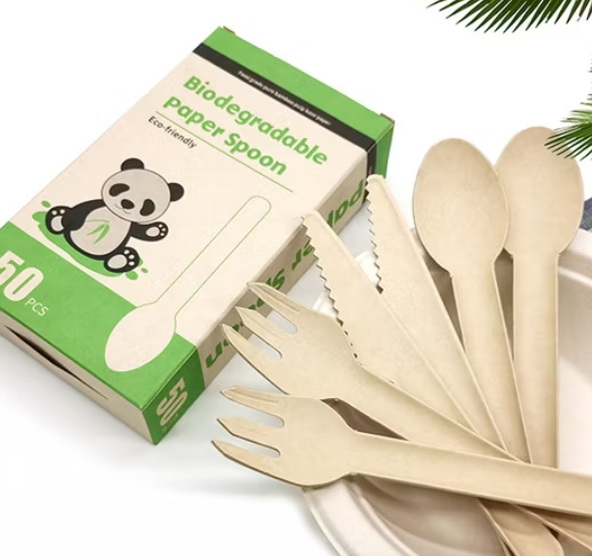
Content Menu
● Introduction to Eco-Friendly Disposable Cutlery
>> Materials Used in Eco-Friendly Cutlery
● Benefits of Eco-Friendly Disposable Cutlery
>> 1. Environmentally Friendly
>> 2. Sustainable
>> 3. Cost-Effective
>> 4. Healthier for Humans and Animals
>> 5. Supports Circular Economy
● Challenges and Limitations
● Consumer Attitudes and Adoption
● Innovations in Biodegradable Materials
● Impact on the Catering Industry
● Future Trends in Eco-Friendly Cutlery
● Case Studies and Examples
● Conclusion
● FAQs
>> 1. What materials are used to make eco-friendly disposable cutlery?
>> 2. Is all biodegradable cutlery compostable?
>> 3. Can eco-friendly disposable cutlery be reused?
>> 4. How does the cost of eco-friendly cutlery compare to traditional plastic cutlery?
>> 5. What are the environmental benefits of using eco-friendly disposable cutlery?
● Citations:
In recent years, the world has witnessed a significant shift towards sustainability, with consumers increasingly opting for eco-friendly products to reduce their environmental footprint. One area where this trend is particularly evident is in the use of eco-friendly disposable cutlery. Traditional plastic cutlery has been a major contributor to plastic pollution, leading to severe environmental issues such as ocean pollution and landfill waste. As a result, biodegradable and compostable alternatives have gained popularity. But are these alternatives truly biodegradable, and what benefits do they offer?

Introduction to Eco-Friendly Disposable Cutlery
Eco-friendly disposable cutlery is made from materials that can be broken down naturally by microorganisms. These materials include cornstarch, bamboo, sugarcane fiber, and wood. Unlike traditional plastic cutlery, which can take hundreds of years to decompose, biodegradable cutlery decomposes much faster and does not release harmful chemicals into the environment.
Materials Used in Eco-Friendly Cutlery
1. Cornstarch: A common material used to make bioplastics, which are compostable and biodegradable. Cornstarch is a renewable resource that can be grown and harvested annually.
2. Bamboo: Known for its rapid growth rate, bamboo is a highly sustainable material. Bamboo cutlery is strong, durable, and does not impart flavors to food.
3. Sugarcane Fiber: Often used in the form of bagasse, sugarcane fiber is another renewable resource that can be used to make biodegradable cutlery.
4. Wood: Wooden cutlery, often made from birch or poplar, is biodegradable and compostable. It offers a natural aesthetic and is suitable for both hot and cold foods.
Benefits of Eco-Friendly Disposable Cutlery
1. Environmentally Friendly
The most significant advantage of eco-friendly disposable cutlery is its environmental friendliness. Unlike traditional plastic cutlery, biodegradable options do not contribute to plastic pollution and can decompose naturally without releasing harmful chemicals.
2. Sustainable
Biodegradable cutlery is made from renewable resources, which can be replenished quickly. This sustainability ensures that the production of these utensils does not lead to deforestation or other environmental issues.
3. Cost-Effective
Eco-friendly disposable cutlery is often more cost-effective than traditional plastic cutlery. Materials like bamboo are inexpensive and can be produced in large quantities, making them affordable options for businesses and consumers. Bulk orders of compostable cutlery are particularly cost-efficient, especially for large-scale catering operations[1].
4. Healthier for Humans and Animals
Biodegradable cutlery does not leach harmful chemicals into food, unlike some traditional plastics. This makes it a safer choice for both humans and animals.
5. Supports Circular Economy
Compostable cutlery supports a circular economy by turning waste into nutrient-rich soil, which can be used to grow more crops. This reduces the need for chemical fertilizers and promotes sustainable agriculture.

Challenges and Limitations
While eco-friendly disposable cutlery offers numerous benefits, there are also challenges and limitations to consider:
- Availability and Cost: Although biodegradable materials are becoming more accessible, they may still be more expensive than traditional plastics in some regions.
- Decomposition Conditions: Biodegradable cutlery requires specific conditions to decompose efficiently, such as industrial composting facilities. In less ideal conditions, decomposition may take longer.
- Strength and Durability: Some biodegradable materials, like plant fibers, may not be as durable as traditional plastics or wooden cutlery.
Consumer Attitudes and Adoption
Consumer attitudes towards eco-friendly disposable cutlery are increasingly positive, driven by concerns about plastic pollution and the desire to reduce carbon footprints. Governments have also implemented regulations to encourage the use of sustainable alternatives. For instance, many countries are introducing bans on single-use plastics, prompting businesses to adopt biodegradable options like PLA and CPLA cutlery[1].
Innovations in Biodegradable Materials
The development of biodegradable cutlery has seen significant advancements with the use of agricultural waste materials such as rice bran, rice husk, wheat straw, and banana leaves[2]. These materials not only reduce plastic waste but also utilize resources that would otherwise be discarded, contributing to a more sustainable future.
Impact on the Catering Industry
The catering industry has seen a significant rise in the adoption of eco-friendly disposable cutlery. Restaurants and event organizers are recognizing the benefits of using biodegradable and compostable materials, not just for environmental impact but also for meeting customer demand for sustainable practices[1]. Offering biodegradable alternatives enhances a company's brand image and aligns with consumer values.
Future Trends in Eco-Friendly Cutlery
As we move into the future, innovations in biodegradable materials, smarter manufacturing processes, and design-forward tableware are leading the industry forward[8]. The integration of technology into everyday products has paved the way for smart disposable cutlery, which can be embedded with sensors to monitor food temperature and quality[7].
Case Studies and Examples
Countries like France and Denmark have implemented policies to reduce plastic waste. For example, Denmark aims to become plastic-free by 2030 and has seen a significant reduction in plastic waste by transitioning to wooden cutlery[4]. Similarly, France has banned certain single-use plastics, encouraging businesses to adopt eco-friendly alternatives.
Conclusion
In conclusion, eco-friendly disposable cutlery is indeed biodegradable and offers a sustainable alternative to traditional plastic cutlery. By choosing biodegradable options, consumers can significantly reduce plastic waste, support renewable resources, and promote a healthier environment. While there are challenges to overcome, the benefits of eco-friendly cutlery make it a worthwhile choice for those committed to sustainability.

FAQs
1. What materials are used to make eco-friendly disposable cutlery?
- Eco-friendly disposable cutlery is made from materials such as cornstarch, bamboo, sugarcane fiber, and wood. These materials are biodegradable and compostable, reducing environmental impact.
2. Is all biodegradable cutlery compostable?
- Not all biodegradable cutlery is compostable. While biodegradable materials can break down naturally, compostable materials specifically break down into nutrient-rich soil under controlled conditions.
3. Can eco-friendly disposable cutlery be reused?
- Eco-friendly disposable cutlery is designed for single use and should not be reused for hygiene and safety reasons.
4. How does the cost of eco-friendly cutlery compare to traditional plastic cutlery?
- Eco-friendly cutlery can be more cost-effective in the long run due to its potential for composting and lower production costs for materials like bamboo. However, initial costs may vary depending on the material and region.
5. What are the environmental benefits of using eco-friendly disposable cutlery?
- The primary environmental benefits include reducing plastic pollution, supporting renewable resources, and promoting a circular economy through composting. This reduces landfill waste and greenhouse gas emissions associated with traditional plastic production.
Citations:
[1] https://www.naturecutlery.com/news/eco-friendly-disposable-cutlery-a-growing-trend-in-the-catering-industry/
[2] https://www.linkedin.com/pulse/green-manufacturing-role-biodegradable-cutlery-pqarf
[3] https://www.c-pac.com/blog/c-pac-chats-1/the-impact-of-environmentally-friendly-cutlery-sets-on-our-planet-68
[4] https://whatisgreenliving.com/best-eco-friendly-disposable-cutlery/
[5] https://yashtech.biz/the-new-era-of-eco-friendly-cutlery/
[6] https://greentekplanet.com/understanding-how-bioplastic-plant-based-cutlery-is-compostable-a-sustainable-choice-for-the-planet/
[7] https://www.persistencemarketresearch.com/market-research/disposable-cutlery-market.asp
[8] https://jollychef.com/blogs/news/the-future-of-disposable-tableware-sustainability-innovation-design-trends-for-2025
[9] https://www.qiaowang.net/industry-news/the-environmental-impact-of-biodegradable-cutlery-a-sustainable-solution-by-qiaowang/
[10] https://www.fortunebusinessinsights.com/biodegradable-cutlery-market-106212
[11] https://supplycaddy.com/what-are-the-innovations-in-biodegradable-disposable-cutlery-materials-from-fork-to-future/
[12] https://refork.com/news/plastic-cutlery-vs-biodegradable-alternatives/
[13] https://www.linkedin.com/pulse/disposable-cutlery-market-towards-eco-friendly-ewzwc
[14] https://www.linkedin.com/pulse/revolutionizing-food-industry-biodegradable-cutlery-i3f6f
[15] https://www.anchenggy.com/blog/the-ultimate-guide-to-biodegradable-disposable-cutlery.html
[16] https://foodhq.world/issue-sections/catering-hospitality/disposables/global-biodegradable-disposable-tableware-market-2023-to-2030-driven-by-environmental-sustainability-trends/
[17] https://www.cpr.cuhk.edu.hk/en/press/cuhk-scientists-develop-naturally-biodegradable-packaging-materials-to-help-local-industry-comply-with-disposable-plastic-utensils-regulations/
[18] https://kisspromotions.com.au/blogs/branding/what-is-the-most-environmentally-friendly-cutlery
[19] https://www.craftecopack.com/blog/the-6-best-eco-friendly-disposable-cutlery-2023_b20
[20] https://www.mviecopack.com/news/the-future-of-catering-embracing-biodegradable-tableware-and-creating-a-sustainable-future-2024-2025/

















